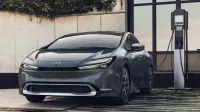Do you need to charge a hybrid car?

It’s impossible to ignore the massive shift happening right now in the automotive world. Most automakers have committed to transforming themselves into electric vehicle manufacturers, and some have even made promises to shift 100 percent of their capacity to EVs. That means a load of new terminology and concepts to understand, but one of the most asked questions has to do with a vehicle type we’ve known and loved for a long time: Hybrids. People hear about plug-in hybrids and EVs needing to be charged and wonder if traditional hybrids fall into the same boat. We’ve put together a quick overview to help you understand how hybrids compare to their plug-in counterparts. Let’s get rolling.
Hybrid electric vehicles (HEVs)
Though they have a battery and at least one electric motor, hybrid vehicles do not need to be charged. Unlike EVs and PHEVs, hybrid batteries recharge through a combination of regenerative braking and excess energy from the gas engine. The battery and electric motor help improve fuel economy by assisting with takeoff and slow-speed driving, and the electric system can also power auxiliary equipment, such as the stereo and climate systems, when the vehicle is parked.
- Read more: What is a hybrid car and why are there different kinds?
Hybrids are sometimes considered a more convenient option because of this. Not needing to charge can be a huge benefit that can save hours each month waiting for a charger, depending on the owner’s driving habits. One significant downside is that the vehicle still requires fuel. Hybrids are also incapable of delivering all-electric range like their plug-in hybrid counterparts, so they don’t offer the ability to run without fuel for any significant amount of time. Their fuel economy benefits also dwindle at highway speeds, as the electric propulsion system isn’t often in use.
Plug-in hybrid electric vehicles (PHEVs)
Plug-in hybrids, or PHEVs, have larger batteries and more robust electric drivetrain components than hybrids. This is because PHEVs offer an all-electric range that can allow some drivers to bypass the gas pump altogether. For example, the 2022 Hyundai Tucson PHEV provides 33 miles of electric range before the gas engine is needed. Once the electric range is exhausted, PHEVs function like any other hybrid, offering electric assistance with low-speed driving.
- Read more: 9 Best Hybrid Cars of 2022 and 2023
PHEVs can make excellent stepping-stone vehicles for people worried about stepping into a dedicated EV. They offer the electric driving experience, and for many people with shorter daily commutes, they can help drivers avoid using gas altogether. That said, they require charging, and people who fail to charge don’t realize much of a fuel economy benefit. Plug-in hybrids are also expensive – sometimes much more so than a comparable gas or hybrid model.
Battery electric vehicles (BEVs or EVs)
Electric vehicles, EVs for most people, run entirely without gas. Owners can drive for a set number of miles and must charge the onboard battery pack to replenish that range. Electric vehicles drive and stop just like gas-powered cars, but electric motors bring a different driving experience that many find favorable over gas. EVs are nearly silent, so there’s no engine noise when accelerating and driving around town. They also offer better torque at low speeds and when taking off from a stop, so acceleration is more intense.
- Read more: Best electric cars and SUVs for 2022 and 2023
- Read more: Cheapest electric cars of 2022
- What do Level 1, Level 2 and DC fast charging (Level 3) mean?
Though charging has come a long way and EVs offer better range estimates than ever, the overall charging experience is still lacking for people in many parts of the country. In some states, there are large expanses of highway without any charging infrastructure, making it extremely difficult to exit and find charging on a trip. The chargers that do exist in some places are inoperable or very slow. And some owners who rent may not be able to easily charge at home.
Frequently asked questions
Do hybrids qualify for federal tax credits?
No, only plug-in vehicles qualify. That means full battery-electric vehicles and plug-in hybrid vehicles only.
How long do hybrid batteries last?
According to J.D. Power, automakers are required to warranty hybrid vehicle batteries for at least eight years or 100,000 miles of use. That said, it’s entirely possible to preserve battery life with careful driving and routine maintenance, and many hybrid vehicles — particularly the segment-defining Toyota Prius — have well-earned reputations for longevity.
Is it worth it to replace a hybrid battery?
In many cases, the answer is yes, especially if the car isn’t that old. Hybrid batteries can cost thousands of dollars, which seems like (and is) a significant financial hit, but the cost of a new car is much more. And don’t forget, traditional gasoline and diesel cars also occasionally need costly work, particularly for their engines and transmissions.
Can I take a hybrid on a road trip?
Of course! In many cases, hybrids offer hundreds of miles on a tank of gas, so you’re free to roam. Keep in mind that hybrids are more fuel efficient at lower speeds, though, so you won’t get the full benefit of electrification on the highway.
Related video:
.embed-container { position: relative; padding-bottom: 56.25%; height: 0; overflow: hidden; max-width: 100%; } .embed-container iframe, .embed-container object, .embed-container embed { position: absolute; top: 0; left: 0; width: 100%; height: 100%; }




